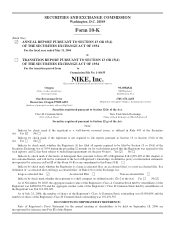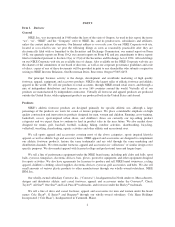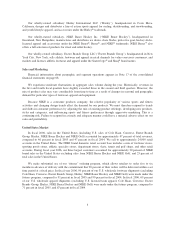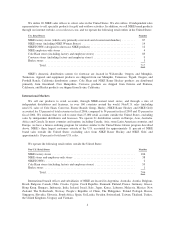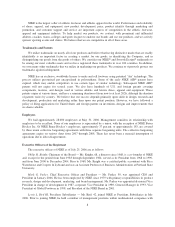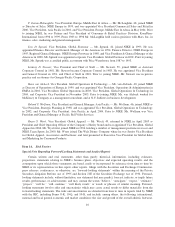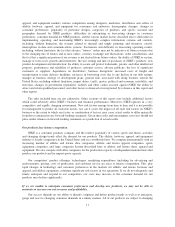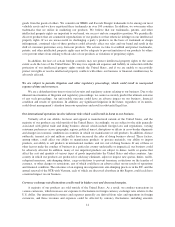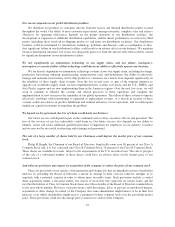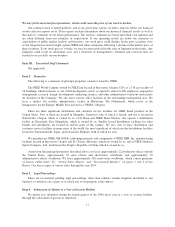Nike 2006 Annual Report Download - page 8
Download and view the complete annual report
Please find page 8 of the 2006 Nike annual report below. You can navigate through the pages in the report by either clicking on the pages listed below, or by using the keyword search tool below to find specific information within the annual report.certain technical criteria and having a CIF (cost, insurance and freight) price above nine euros (“Special
Technology Athletic Footwear” or “STAF”), was excluded from the quotas. As a result of the STAF exclusion,
and the amount of quota made available to us, the quotas did not have a material effect on our business.
However, as part of China’s 2001 accession to the World Trade Organization (“WTO”), China entered into an
agreement with the EU and other WTO members to abide by a special safeguard arrangement whereby quotas
could be imposed on any product sourced in China, including footwear, if there was a surge in imports from
China into another WTO country, and after a legal proceeding it was determined that such imports were injuring
a domestic producer. Additionally, under longstanding WTO rules, all WTO member countries reserved the right
to impose (1) safeguard measures (temporary quotas) if it can be demonstrated in a legal proceeding that
increased imports are injuring another WTO member’s domestic industry; and (2) anti-dumping measures if it
can be demonstrated in a legal proceeding that imports are being sold at an unfair low price in another WTO
member’s home market, and those imports were causing or threatening to cause material injury to the domestic
industry.
Accordingly, with the phase-out of the quotas at the beginning of 2005, and the expiration of a separate EU
anti-dumping case in 2003 against footwear made in China, Indonesia, and Thailand, there has been renewed
pressure from some parts of the EU footwear manufacturing sector to re-impose some level of trade protection on
imported footwear from China, India, Vietnam, and other exporting countries. In July 2005, the European
Commission, at the request of the European domestic footwear industry, initiated investigations into leather
footwear imported from China and Vietnam. NIKE and all other major athletic footwear manufacturers are
currently participating actively as respondents in this investigation and are taking the position that athletic
footwear (i) should not be within the product scope of this investigation and (ii) does not meet the legal
requirements of injury and price in an anti-dumping investigation. The EU agreed on provisional anti-dumping
duties in March 2006 but excluded STAF from the measures. We anticipate that the definitive anti-dumping
duties will be adopted by early October 2006 and we expect STAF to be excluded from the final measures. We
believe that our major competitors stand in much the same position regarding these potential trade measures.
Vietnam Imports into the United States
We currently source a portion of our footwear and apparel products from factories in Vietnam. In 2001, the
United States Congress and the Vietnamese National Assembly approved a comprehensive bilateral trade
agreement, which, among other things, provides reciprocal, non-discriminatory Normal Trade Relations (“NTR”)
between the U.S. and Vietnam. Following that approval, the U.S. granted an annual extension of NTR to
Vietnam. The U.S. President must renew this grant annually with the opportunity for review by Congress. In June
2006, President Bush renewed NTR for Vietnam for an additional year and we anticipate Congress will support
this decision, as it has done for the past five years. Additionally, in the spring of 2006 Vietnam finished its WTO
accession negotiations with several WTO countries and has embarked on entering the WTO as a full member.
Legislation has been introduced within Congress to provide Vietnam Permanent Normal Trade Relations
(“PNTR”) and we anticipate Congressional approval of this legislation in 2006. Vietnam’s entry into the WTO
and the U.S. providing Vietnam PNTR will provide us greater certainty about our business within Vietnam. It
will likewise enable us to further expand our production and marketing opportunities in Vietnam and allow for
Vietnamese-sourced products to continue to enter the United States at NTR tariff rates.
Competition
The athletic footwear, apparel and equipment industry is keenly competitive in the United States and on a
worldwide basis. We compete internationally with an increasing number of athletic and leisure shoe companies,
athletic and leisure apparel companies, sports equipment companies, and large companies having diversified
lines of athletic and leisure shoes, apparel and equipment, including Adidas and others. The intense competition
and the rapid changes in technology and consumer preferences in the markets for athletic and leisure footwear
and apparel, and athletic equipment, constitute significant risk factors in our operations.
7

